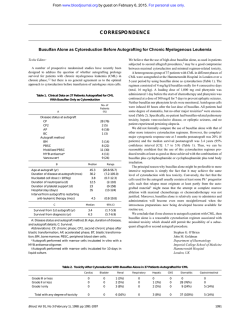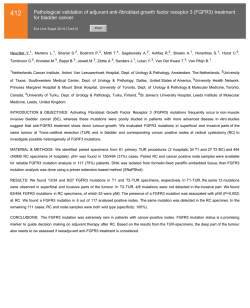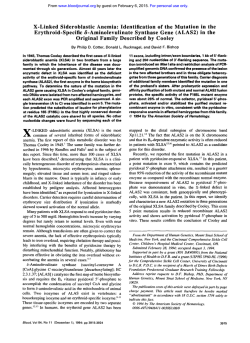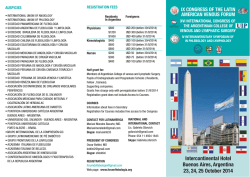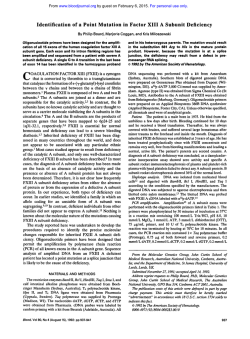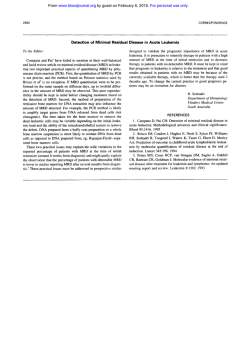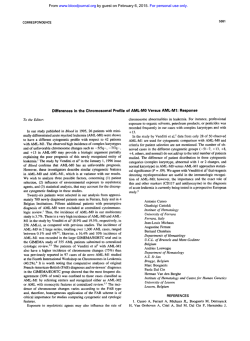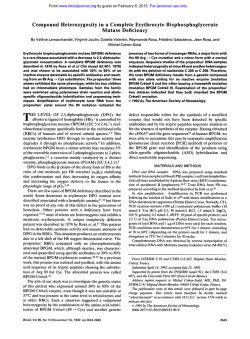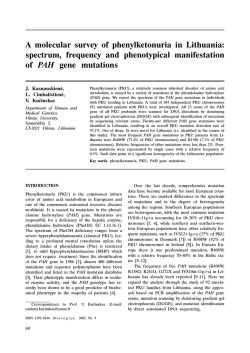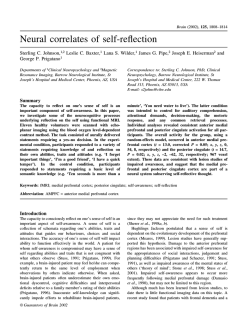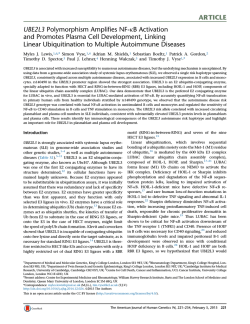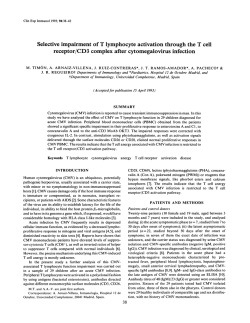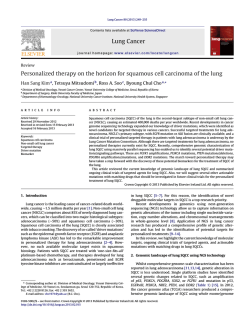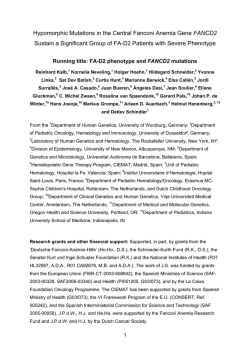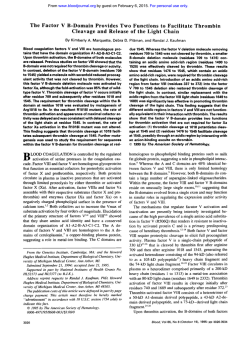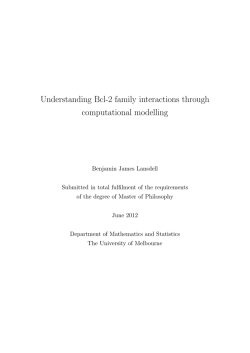
The Prothrombin G20210A Mutation and Factor V Leiden
From www.bloodjournal.org by guest on February 6, 2015. For personal use only. 704 CORRESPONDENCE mechanism is the first physiologic pathway by which the kallikrein/ kinin system can be activated in vivo. We do not believe that this PK activation system is constitutively active in vivo. The amount of high molecular weight kininogen (HK) necessary for maximal PK activation is limited by the number of kininogen receptors on cells and not the ambient plasma concentration. How HK modulates the activity of this enzyme needs to be examined further. Furthermore, HK is not the single regulator of activation of this pathway. In a study now in press, we show that activation of this pathway also is dependent on an optimal free zinc ion concentration.4 In the absence of an optimal free zinc ion concentration, the system is quiescent. These data suggest that the local liberation of zinc ion may be the immediate regulator of activation of this system. Furthermore, we show that on endothelial cells, factor XII (FXII) does not autoactivate in any reasonable period of time (,1 hour) and that FXII activation is dependent on PK activation and not vice versa.4 Activated FXII is then able to reciprocally activate more plasma PK. We agree that our proposed pathway for contact system activation is not a substitute for the role of anionic surfaces (dirt, cardiopulmonary bypass tubing, bacteria, etc) in FXII activation in nonphysiologic states. Furthermore, we agree that Dr Hack’s DDAVP infusion experiments suggest that, in response to endothelial cell agonists, FXII activation can initiate PK activation.5 It was an unintended oversight not to refer to the FXII-dependent pathway of plasminogen activation described by Levi et al.5 As described by Dr Hack, the presence of an artificial surface potentiates FXIIa’s activation of plasminogen. This pathway, which may become operative in nonphysiologic states, can be conjoined with the proposed physiologic contact system pathways for fibrinolysis mediated by bradykinin-induced tPA liberation and kallikrein activation of single-chain urokinase.2,3,6 Last, it is not rigorously proven that FXII-deficient patients are at increased risk for thrombosis. Furthermore, because PK and HK deficiencies are so rare, there have not been sufficient number of individuals described with these defects to deter- mine if they have less of a risk for thrombosis than FXII-deficient patients. Alvin H. Schmaier Rasmus Røjkjaer Department of Internal Medicine Division of Hematology and Oncology The University of Michigan Medical Center Ann Arbor, MI REFERENCES 1. Colman RW, Schmaier AH: Contact system: A vascular biology modulator with anticoagulant, profibrinolytic, antiadhesive, and proinflammatory attributes. Blood 90:3819, 1998 2. Motta G, Rojkjaer R, Hasan AAK, Cines DB, Schmaier AH: High molecular weight kininogen regulates prekallikrein assembly and activation on endothelial cells: A novel mechanism for contact activation. Blood 91:516, 1998 3. Lin Y, Harris RB, Yan W, McCrae KR, Zhang H, Colman RW: High molecular weight kininogen peptides inhibit the formation of kallikrein on endothelial cell surfaces and subsequent urokinasedependent plasmin formation. Blood 90:690, 1997 4. Rojkjaer R, Hasan AAK, Motta G, Schousboe I, Schmaier AH:Factor XII is not required to initiate prekallikrein activation on endothelial cells. Thromb Haemost (in press) 5. Levi M, Hack CE, Do Boer JP, Brandjes DPM, Buller HR, ten Cate WJ: Reduction of contact activation related fibrinolytic activity in factor XII deficient patients. Further evidence for the role of the contact system in fibrinolysis in vivo. J Clin Invest 88:1155, 1991 6. Brown NJ, Nadeau JH, Vaughan DE: Selective stimulation of tissue-type plasminogen activator (t-PA) in vivo by infusion of bradykinin. Thromb Haemost 77:522, 1997 The Prothrombin G20210A Mutation and Factor V Leiden Mutation in Patients With Cerebrovascular Disease To the Editor: Genetic variants leading to a persistent hypercoagulable state may predispose to thrombotic events. A recently discovered G to A mutation at position 1691 of the factor V gene (factor V Leiden mutation), occurring in 3% to 5% of the normal Caucasian population, has emerged as a major genetic risk factor of venous thrombosis.1 The role of this mutation for arterial vascular events, in particular cerebrovascular disease, is still under discussion.2-6 Another recently described mutation (G to A at position 20210 in the 38-untranslated region of the prothrombin gene) has been associated with a threefold increased risk of venous thrombosis in heterozygous carriers of the mutation.7 The mutation is as frequent as 1% to 2% in the population and also seems to represent an important genetic risk factor of venous thrombosis. Currently, the role of the prothrombin variation for arterial vascular disease is unclear. In a recent study, 5.1% heterozygous carriers of the mutation among young women with myocardial infarction were found, compared with 1.6% heterozygous carriers among a control population.8 The age-adjusted odds-ratio for MI was 4.0 and was particularly high in the presence of other vascular risk factors, eg, smoking. In another recent study, the G20210A prothrombin mutation was found in 5.1% of 98 patients with coronary heart disease as compared with 1.96% among healthy newborns.9 On the other hand, three studies did not find a significantly increased prevalence of the mutation in patients with cerebrovascular disease.10-12 Only in one of these studies were cerebrovascular risk factors detailed,10 and only one study also analyzed the presence of the factor V Leiden mutation in ageand sex-matched control subjects.12 Furthermore, patients were highly selected in one of these studies,11 with 30 of 125 patients suffering from arterial dissection as the cause of cerebral infarction. Another study found no increased prevalence of the prothrombin G20210A mutation in patients with cerebrovascular disease13; however, a synergistic role of the prothrombin mutation and the factor V Leiden mutation in the development of thrombosis was observed. To date, no study has evaluated the effect of the factor V Leiden mutation and the G20210A prothrombin mutation in patients with cerebrovascular disease and ageand sex-matched control subjects under particular consideration of other vascular risk factors in patients with and without the prothrombin G20210A mutation. We investigated the prevalence of the factor V Leiden mutation and the G20210A prothrombin mutation in 96 patients with transient ischemic attacks (TIA) or minor strokes (MS; 58 men and 38 women; age [x 6 s], 64.4 6 13.1 years; range, 28 to 91 years) and in 96 age(610 years) and sex-matched control subjects free of clinically manifest vascular disease. Furthermore, we compared history, clinical data, and the prevalence of risk factors for stroke between patients with From www.bloodjournal.org by guest on February 6, 2015. For personal use only. CORRESPONDENCE and without the G20210A prothrombin mutation. All patients underwent cranial computerized tomography, duplex sonography of carotid and vertebral arteries, and a thorough cardiac investigation (including electrocardiography, transthoracic echocardiography, as well as transesophageal echocardiography in selected cases). In addition, all patients were evaluated with respect to the generally accepted risk factors for stroke and any coexisting diseases, in particular coronary heart disease, peripheral arterial disease, and venous thrombosis. Concerning the presumed etiology of stroke, each patient was assigned to one of the following four groups14: lacunar (n 5 23; 24.0%); atherothrombotic (n 5 33; 34.4%); cardioembolic (n 5 24; 25.0%); or undetermined (n 5 16; 16.6%). The prevalence of the 20210 AG genotype was equal in patients and in control subjects, with 5 of 96 subjects in each group (patients: 4 men and 1 woman; mean age, 64 years; control subjects: 3 men and 2 women; mean age, 63 years; odds ratio [OR], 1.0; 95% confidence interval [CI], 0.52 to 1.91). The prevalence of the factor V Leiden mutation was 8 of 96 in the patient group (5 men and 3 women; mean age, 60 years) and 5 of 96 in the control group (3 men and 2 women; mean age, 60 years; OR, 1.65; 95% CI, 0.92 to 2.98). One patient (53-year-old man) and none of the control subjects was homozygous for the factor V Leiden mutation. One patient (67-year-old man) and none of the control subjects carried both mutations. This patient had experienced recurrent cerebrovascular events (starting at the age of 60 years) and one myocardial infarction (at the age of 65 years) but had no history of venous thrombosis. Coronary artery disease had become manifest at the age of 45 years (angina pectoris). However, this patient also had multiple other vascular risk factors (hypertension, hypercholesterolemia, overweight, and cigarette smoking). Patients exhibiting the prothrombin wild-type genotype and patients carrying the G20210A prothrombin mutation were not different with regard to current age, age at the time of the first cerebrovascular event, or age at the time of the first vascular event (cerebral/cardiac/peripheral arterial system or venous). Recurrent cerebrovascular events were reported by 1 of 5 carriers of the 20210 GA genotype and by 4 of 91 carriers of the wild-type (not significant [NS]). The prevalence of ischemic cardiac disease was 3 of 5 in carriers of the GA genotype and 28 of 91 in carriers of the GG genotype (NS). The prevalence of peripheral arterial disease was 1 of 5 in carriers of the GA genotype and 8 of 91 in carriers of the GG genotype (NS). Two of five patients with the GA genotype and 13 of 91 patients with the GG genotype reported a history of deep-vein thrombosis (with and without pulmonary embolism; NS). Carotid artery disease was present in 1 of 5 of the GA patients and in 11 of 91 of the GG patients. The etiology of the cerebrovascular event in the 5 carriers of the GA genotype was classified as lacunar (n 5 1), atherothrombotic (n 5 3), and cardioembolic (n 5 1). This distribution was not significantly different from that in the patients carrying the wild-type. Comparing the risk factors for stroke, no significant differences were found between the two groups with respect to cardiac disease, hypertension, diabetes mellitus, hypercholesterolemia, hyperfibrinogenemia, alcohol abuse (history), cigarette smoking (recent), history of other drug abuse, and oral contraceptive use. In conclusion, our data do not suggest a role for the G20210A mutation as a relevant risk factor for TIA/MS in an unselected group of patients. We did not find evidence for an effect of the factor V Leiden mutation or an increased combined occurrence of both mutations in patients with TIA/MS. In comparison with carriers of the wild-type, the carriers of the 20210 GA genotype did not show distinct clinical features or a distinct risk factor profile. The question whether the G20210A prothrombin mutation, alone or in combination with other vascular risk factors, increases the risk of cerebrovascular disease in 705 specific populations (as it could be shown for myocardial infarction8) remains to be answered in further studies. Wolfgang Lalouschek Susanne Aull Wolfgang Series Karl Zeiler University Clinic for Neurology Christine Mannhalter Department of Laboratory Medicine Molecular Biology Division University Vienna Medical School Vienna, Austria REFERENCES 1. Dahlba¨ck B: Factor V gene mutation causing inherited resistance to activated protein C as a basis for venous thromboembolism. J Intern Med 237:221, 1995 2. Ridker PM, Hennekens CH, Lindpaintner K, Stampfer MJ, Eisenberg PR, Miletich JP: Mutation in the gene coding for coagulation factor V and the risk of myocardial infarction, stroke, and venous thrombosis in apparently healthy men. N Engl J Med 332:912, 1995 3. Markus HS, Zhang Y, Jeffery S: Screening for the factor-V Arg 506 Gln mutation in patients with TIA and stroke. Cerebrovasc Dis 6:360, 1996 4. Albucher JF, Guiraud Chaumeil B, Chollet F, Cadroy Y, Sie P: Frequency of resistance to activated protein C due to factor V mutation in young patients with ischemic stroke. Stroke 27:766, 1996 5. De Lucia D, Cerbone AM, Belli A, Di Mauro C, Renis V, Conte MM, Rocino A, Papa ML, de Biasi R: Resistance to activated protein C in adults with a history of juvenile transient ischaemic attacks. Thromb Haemost 76:627, 1996 6. Landi G, Cella E, Martinelli I, Tagliabue L, Mannucci PM, Zerbi D: Arg506Gln factor V mutation and cerebral ischemia in the young. Stroke 27:1697, 1996 7. Poort SR, Rosendaal FR, Reitsma PR, Bertina RM: A common genetic variation in the 38untranslated region of the prothrombin gene is associated with elevated plasma prothrombin levels and an increase in venous thrombosis. Blood 88:3698, 1996 8. Rosendaal FR, Siscovick DS, Schwartz SM, Psaty BM, Raghunathan TE, Vos HL: A common prothrombin variant (20210 G to A) increases the risk of myocardial infarction in young women. Blood 90:1747, 1997 9. Watzke HH, Schuttrumpf J, Graf S, Huber K, Panzer S: Increased prevalence of a polymorphism in the gene coding for human prothrombin in patients with coronary heart disease. Thromb Res 87:521, 1997 10. Corral A, Gonzalezconejero R, Lozano ML, Rivera J, Heras I, Vicente V: The venous thrombosis risk factor 20210 a allele of the prothrombin gene is not a major risk factor for arterial thrombotic disease. Br J Haematol 99:304, 1997 11. Bentolila S, Ripoll L, Drouet L, Mazoyer E, Woimant F: Thrombophilia due to 20210 G = A prothrombin polymorphism and cerebral ischemia in the young. Stroke 28:1846, 1997 12. Martinelli I, Franchi F, Akwan S, Bettini P, Merati G, Mannucci PM: The transition G to A at position 20210 in the 38 untranslated region of the prothrombin gene is not associated with cerebral ischemia. Blood 90:3806, 1997 13. Ferraresi P, Marchetti G, Legnani C, Cavallari E, Castoldi E, Mascoli F, Ardissino D, Palareti G, Bernardi F: The heterozygous 20210 G/A prothrombin genotype is associated with early venous thrombosis in inherited thrombophilias and is not increased in frequency in artery disease. Arterioscler Thromb Vasc Biol 17:2418, 1997 14. Whisnant JP, Basford JR, Bernstein EF, Cooper ES, Dyken ML, Easton JD, Little JR, Marler JR, Millikan CH, Petito CK, Price TR, Raichle ME, Robertson JT, Thiele B, Walker MD, Zimmermann RA: Classification of cerebrovascular diseases III. Stroke 21:637, 1990 From www.bloodjournal.org by guest on February 6, 2015. For personal use only. 1998 92: 704-705 The Prothrombin G20210A Mutation and Factor V Leiden Mutation in Patients With Cerebrovascular Disease Wolfgang Lalouschek, Susanne Aull, Wolfgang Series, Karl Zeiler and Christine Mannhalter Updated information and services can be found at: http://www.bloodjournal.org/content/92/2/704.full.html Articles on similar topics can be found in the following Blood collections Information about reproducing this article in parts or in its entirety may be found online at: http://www.bloodjournal.org/site/misc/rights.xhtml#repub_requests Information about ordering reprints may be found online at: http://www.bloodjournal.org/site/misc/rights.xhtml#reprints Information about subscriptions and ASH membership may be found online at: http://www.bloodjournal.org/site/subscriptions/index.xhtml Blood (print ISSN 0006-4971, online ISSN 1528-0020), is published weekly by the American Society of Hematology, 2021 L St, NW, Suite 900, Washington DC 20036. Copyright 2011 by The American Society of Hematology; all rights reserved.
© Copyright 2025
